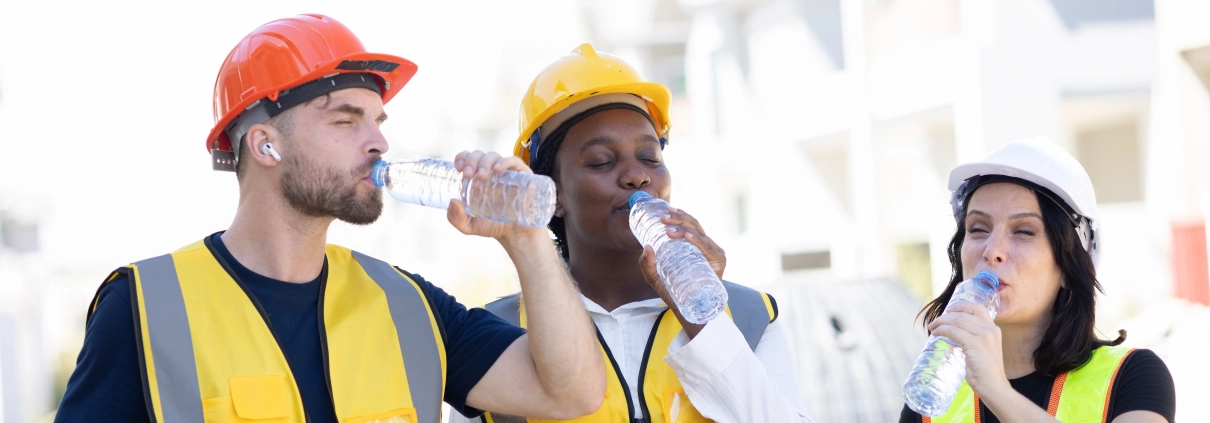Working in Hot Conditions
When temperatures soar, working in hot conditions can pose serious health and safety risks to workers: whether it’s outdoor construction work during a summer heatwave or indoor roles in hot environments like kitchens or foundries. Employers and employees must be aware of their legal responsibilities and take steps to ensure personnel stay safe.
The Law Around Working in Hot Conditions
In the UK, there is no specific maximum working temperature set by law. However, under the Health and Safety at Work etc. Act 1974, employers have a duty of care to ensure the health, safety, and welfare of employees.
The Workplace (Health, Safety and Welfare) Regulations 1992 state that temperatures in all indoor workplaces must be “reasonable” — this includes taking into account the nature of the work and environmental conditions. For outdoor work, the same duty of care applies, and risk assessments must consider heat as a hazard.
The Management of Health and Safety at Work Regulations 1999 also require employers to conduct risk assessments for workplace hazards, including heat stress. and take appropriate action.
What are the ill Effects of Working in Hot Conditions?
Hot temperatures can increase the risk of a number of health and safety issues, including:
Heat Stress
Occurs when the body’s temperature regulation system is overwhelmed, causing symptoms such as: irritability, loss of concentration, and reduced performance
Heat Exhaustion
A reaction to excessive loss of water and salts through sweating, leading to dizziness, weakness, headache, and nausea.
Heat Stroke
A life-threatening condition where body temperature rises dangerously high (above 40°C), causing confusion, seizures, loss of consciousness, and potentially death if not treated quickly.
Sunburn
Skin damage caused by excessive exposure to ultraviolet (UV) radiation from the sun, leading to redness, pain, peeling, and an increased long-term risk of skin cancer.
Dehydration
When the body loses more fluids than it takes in, it leads to dry mouth, tiredness, dizziness, and reduced mental and physical performance.
Increased Accident Risk
Heat can cause fatigue, slower reaction times, and poor decision-making, which heightens the risk of mistakes and injuries.
What can be done to help reduce the risks?
Employers can take several steps to protect workers from heat-related hazards:
1. Risk Assessment
Identify heat hazards and assess who might be at risk, considering factors like workload, environment, workers’ individual needs, vulnerable workers needs, and protective clothing.
2. Reduce Exposure
- Schedule strenuous tasks for cooler parts of the day.
- Rotate workers to reduce time spent in hot areas.
- Provide shaded rest areas for outdoor workers.
3. Improve Ventilation & Cooling
- Use fans, air conditioning, or evaporative cooling where possible.
- Increase airflow in enclosed spaces such as opening windows.
4. Hydration & Breaks
- Provide easy access to cool drinking water.
- Encourage regular water breaks, even if workers aren’t thirsty.
5. Clothing & PPE
- Supply lightweight, breathable clothing for hot conditions.
- Where PPE is necessary, select designs that minimise heat build-up.
7. Covering up
- Wear clothing which covers bare skin.
- Keep your top on.
- Wear a hat with a brim or a flap that covers the ears and the back of the neck.
- Stay in the shade whenever possible, during your breaks and especially at lunch time.
- Use a high factor sunscreen of at least SPF15, on any exposed skin.
- Drink plenty of water to avoid dehydration.
- Check your skin regularly for any unusual moles or spots. See a doctor promptly if you find anything that is changing in shape, size or colour, or is itching or bleeding.
7. Training & Awareness
- Educate workers on the signs and symptoms of heat-related illnesses and the measures they should use to protect themselves.
- Encourage prompt reporting of symptoms.
Conclusion
While working in hot conditions cannot always be avoided, the risks can be managed. Employers must meet their legal duties to keep temperatures reasonable and prevent heat stress, while workers should take proactive steps to protect themselves. By combining good planning, effective control measures, and clear communication, heat-related risks can be greatly reduced.
Contact us today to discuss your requirements.
*Disclaimer: Please note that it is the duty of the employer to carry out a suitable and sufficient risk assessment to ensure that adequate controls are in place to protect workers against hot environments. This page is for information purposes only and does not constitute legal advice. The information on this page is intended as an overall introduction to working in hot environments. Practical Safety Ltd aims to avoid, but accepts no liability, if any information stated is incorrect or out of date.



